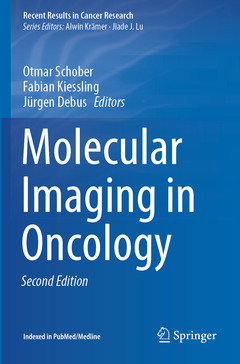Molecular Imaging in Oncology (2nd Ed., 2nd ed. 2020) Recent Results in Cancer Research Series, Vol. 216
Coordonnateurs : Schober Otmar, Kiessling Fabian, Debus Jürgen

Computed tomography and magnetic resonance imaging.- Single photon emission computed tomography – tracer.- Non-peptidyl 18F-labelled PET tracers as radioindicators for the noninvasive detection of cancer.- Ultrasound Imaging.- Optical and opto-acoustic imaging.- Multifunctional magnetic imaging probes.- Modern X-ray concepts-differential phase-contrast imaging.- Pre-clinical SPECT and SPECT-CT.- Optical and photo-acoustic imaging.- Applications of small animal PET.- Preclinical molecular imaging using PET and MRI.- Molecular ultrasound imaging.- Advanced microscopy techniques.- Mass spectroscopy.- Quantitative SPECT-CT.- Optical imaging of breast tumors and of gastrointestinal cancer by laser-induced fluorescence.- FDG PET and PET-CT.- Non-FDG PET-CT.- Clinical MR biomarkers.- Clinical PET-MR.- Advanced ultrasound imaging.- Radiomics and Radiogenomics.- Cross validation techniques.- Image-guided brain surgery.- Image-guided abdominal surgery.- Photon radiation therapy.- Particle radiation therapy.- Internal radiotherapy.- Future challenges of multimodality imaging.
Otmar Schober was Director of the Department of Nuclear Medicine at the University of Münster from 1988 to 2013 and Deputy Rector of the university from 1994 to 1998. He has extensive expertise in the natural sciences and clinical medicine and has focused on imaging methods and their implementation in preclinical and clinical applications. Professor Schober completed his studies in laser physics with Herbert Welling and in surface physics with Nobel Laureate Gerhard Ertl at the Universities of Hanover and Munich. He received his medical training in Frankfurt, Hanover, and London; Heinz Hundeshagen was his mentor. From 1995 to 2003, he was a German Research Foundation expert reviewer for Radiology, Nuclear Medicine, and Radiation Biology. He has served as Editor-in-Chief of the Journal Nuklearmedizin (2001–2011) and as a coeditor of various international journals. Professor Schober served as coordinator of the Collaborative Research Center on Molecular Cardiovascular Imaging from 1999 to 2013. As a founder of the European Institute for Molecular Imaging, he was the principal investigator at the Cluster of Excellence “Cells in Motion.”
Fabian Kiessling leads the Institute for Experimental Molecular Imaging at the RWTH University in Aachen, where he is working to develop novel diagnostic and theranostic concepts, probes, and technologies. Professor Kiessling studied medicine at Heidelberg University and subsequently worked as a resident at the Department of Radiology, German Cancer Research Center (until the end of 2002). In 2003, he moved to the Department of Medical Physics in Radiology as leader of a Molecular Imaging Group. At the same time, he pursued his clinical training, becoming a board-certified radiologist in 2007. He is the author of more than 300 publications and book chapters and has been an editorial board member for various journals, including Radiology, European Radiology, Molecular Imaging and Biology, and Nanotheranostics. In 201
Covers the full spectrum of oncological molecular imaging, from basic research to clinical practice
Discusses emerging technologies and probe designsfor different modalities
Addresses both preclinical and clinical applications
Examines the emerging role of molecular imaging in the context of external and internal radiotherapy
Date de parution : 06-2021
Ouvrage de 918 p.
15.5x23.5 cm
Date de parution : 06-2020
Ouvrage de 918 p.
15.5x23.5 cm
Thèmes de Molecular Imaging in Oncology :
Mots-clés :
Oncological Molecular Imaging; Standardized and Emerging Technology; PET; SPECT; Optical and Optoacoustic Imaging; Multiscale Preclinical Applications; Advanced Microscopy; Image-guided Surgery; Radiomic Analysis; Multifunctional magnetic imaging probes; Photon radiation therapy; Diagnostic Radiology



